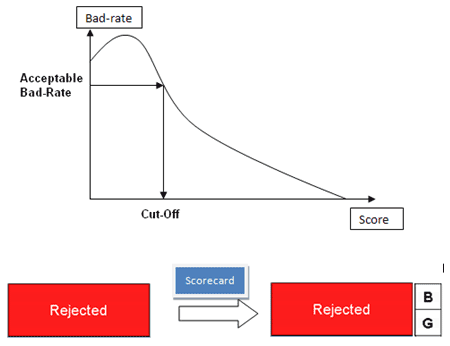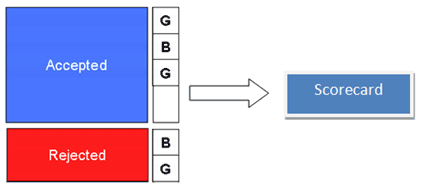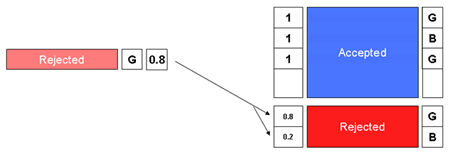
It can be very dangerous to base lending decisions solely on the behaviors and characteristics of accepted borrowers, or clients. In fact, poor lending rules can be exacerbated and millions of dollars lost if lending institutions do not properly and accurately develop their lending policies, and “acceptance” guidelines. Developing a solid and sound model (or scorecard) using a reject inference can substantially increase the size, and quality of a customer base or portfolio.
In this article, we will look at the use and development of reject inferences for the purpose of raising profits and increasing market share.
1. What is Reject Inference
A Reject Inference is a method for improving the quality of a scorecard based on the use of data contained in rejected loan applications.
When developing a scorecard, we normally use information on those borrowers who have previously been granted a loan. However, the number of potential customers is significantly higher and a correctly developed scorecard must be able to perform as expected in the context of the entire population of potential customers.
The behavior of new types of borrowers can significantly differ from the behavior of the borrowers included in our credit portfolio.
To improve our knowledge of potential borrowers, we can use information on those customers who applied for and were refused a loan.
To develop a scorecard, we need to identify each borrower either as a "good" one or a "bad" one. However, there is no information available for rejected loan applications. We cannot tell for sure, to which group a borrower would have belonged, had he/she been granted a loan. The Reject Inference methods are intended to provide the most correct way to perform the Good-Bad identification of rejected applications in order to include them into the development set, based on which we can build a scorecard. Based on this new scorecard and the “RI” approach, we can then determine what the impact of our policies and decisions truly are, and ultimately make adjustments and corrections as we attempt to grow our business.
2. Simple Augmentation
The simplest way to include information on rejects is to evaluate them using the existing scorecard; rejected loan applications can be used afterwards to adjust the scorecard.
This method is called Simple Augmentation.
The first step involves developing a scorecard using the information on approved loan applications:
Using the resulting scorecard, we can evaluate the set of rejects; rejects are evaluated as "good" or "bad" based on the acceptable bad rate value.
Finally, a joint set of approved and rejected applications is used to adjust the parameters of the scorecard:
The most obvious drawback of the Simple Augmentation algorithm is the fact that rejects are evaluated using only the actual scorecard. In fact, the scorecard can cause errors, for example, due to differences in the characteristics of the credit portfolio and those in the set of rejects.
Besides, the algorithm does not take into account the probability of a loan applications being approved or rejected. Using the algorithms results in treating approval chances of approved and rejected loan applications as identical, which is undoubtedly not true.
3. Fuzzy Augmentation
The most accurate approach to the processing of data contained in rejected loan applications is called Fuzzy Augmentation. This method involves using rejects with weight values that correspond to the probability of a given loan application being approved or rejected.
The first step involves developing a scorecard using the information on approved loan applications:
Then, using the resulting scorecard, we evaluate the set of rejects:
For each rejected application, there are two records containing the weight values that correspond to the probabilities:
The joint dataset that is extended due to the "double" number of rejects is used to adjust the parameters of the scorecard:
The use of both the probability of rejection and the probability of approval of a reject allows adjusting the parameters of the score to cover either of the two possible types of behavior ("good" or "bad").







